#Wei and Jin Dynasty-Northern and Southern Dynasties(220—589)
Explore tagged Tumblr posts
Text
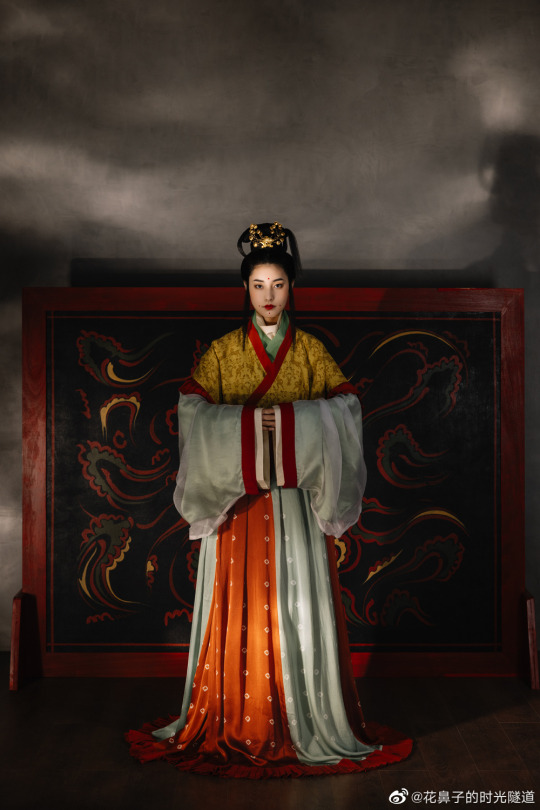


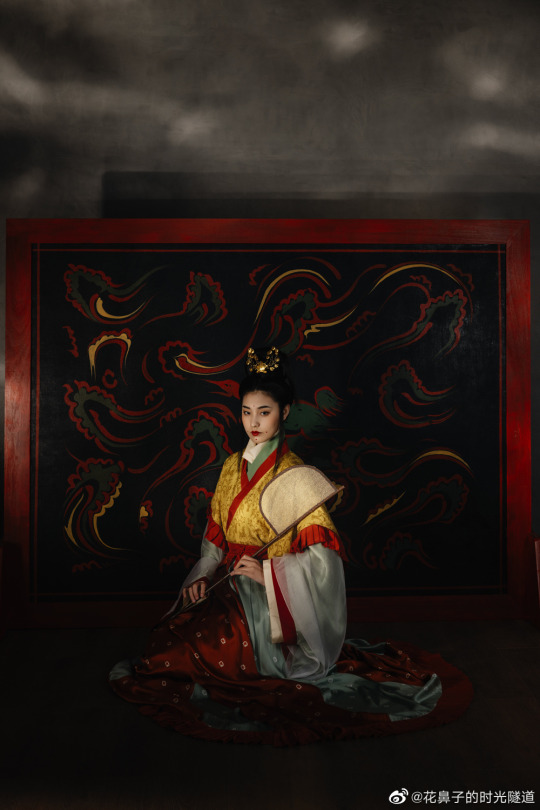

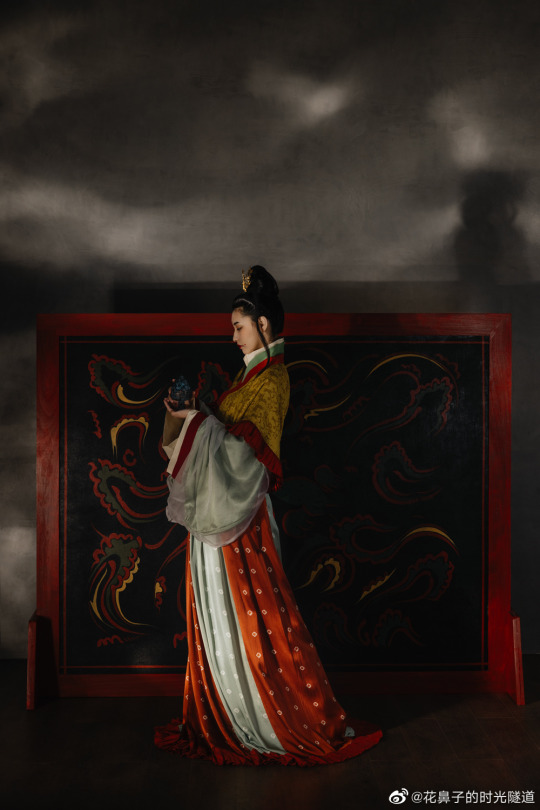
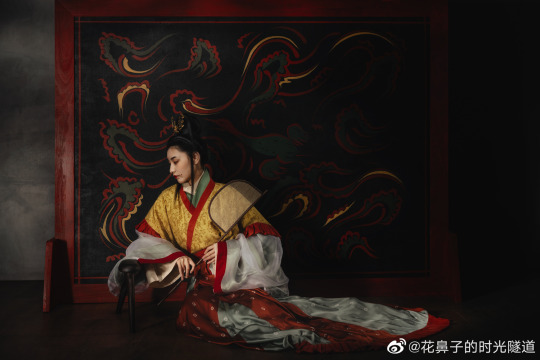

【Historical Reference Artifacts】:
China Jin Dynasty PaintingBy Gu Kaizhi (顾恺之)
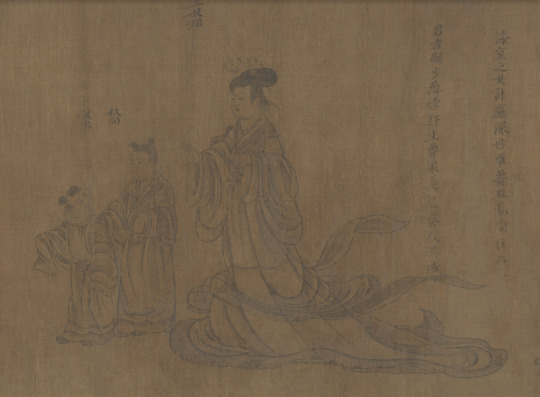
・ Wei, Jin, Southern and Northern Dynasties Female Figurines showing woman makeup at the time:
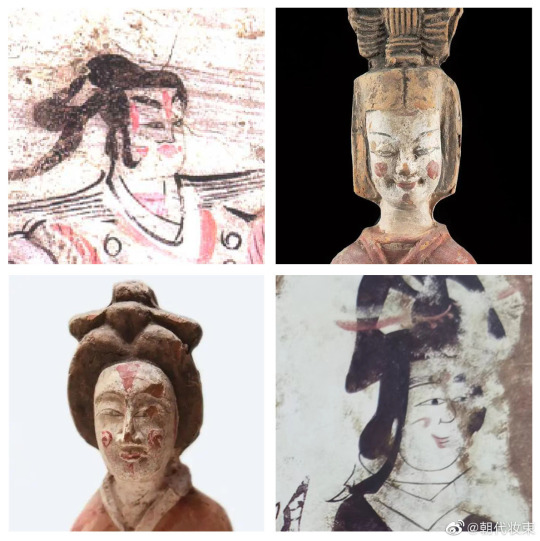

[Hanfu・漢服]Chinese Wei and Jin Dynasty-Northern and Southern Dynasties(220—589)Traditional Clothing Hanfu Photoshoot
————————
📷Photo:@realyn
💄Stylist:@仰望的花鼻子
🔗Weibo:https://weibo.com/5541803701/N77vXcOBE
————————
#chinese hanfu#Wei and Jin Dynasty-Northern and Southern Dynasties(220—589)#hanfu#hanfu accessories#hanfu_challenge#chinese traditional clothing#china#chinese#chinese history'#historical fashion#historical makeup#Wise and Benevolent Women (列女仁智圖)#chinese history#ancient china#chinese fashion#hanfu art#漢服#汉服#chinese style#中華風#魏晋南北朝
238 notes
·
View notes
Text




(Not done with the Qin/Han robes yet, but taking a quick break to hop to the next time period for something a bit different.)
魏晋南北朝的襦裙 Ruqun (2-piece outfit) during the Wei-Jin + Northern/Southern Dynasties (220 - 589 AD)
This time period spans over 350 years and incorporates: 1) the Three Kingdoms era, 2) the Jin Dynasty, 3) the Northern/Southern dynasties
History background: Towards the end of the Eastern Han dynasty, the Han empire split into three kingdoms (Wei, Han, Wu) with Wei being the most powerful. Following almost a century of fighting, the three kingdoms were unified under the Jin Dynasty. Unfortunately, this didn't bring peace to the country as power struggles continued. Due to the continuous fighting, China's population was reduced drastically and many tribes from the north attacked, hoping to enlarge their own territory. This was a period of non-stop fighting and conflict, and it wasn't until the Sui Dynasty(581- 618 AD) that the country once again found peace.
Hanfu during this period: In terms of Hanfu, many new styles appeared influenced by a clash of different ethnic groups and cultures. In the Eastern Han/Three Kingdoms period, Hanfu started to evolve from a 1-piece long robe (known as "Shenyi"/深衣) to a 2-piece set with the top and bottom separated (known as "Ruqun"/襦裙). The bottom skirt is pieced together using several long, rectangular pieces, pleated at the top and attached to a waist belt, allowing the bottom to flare out.
This 2-piece Ruqun style reached a peak during the Wei-Jin Northern/Southern dynasties period, and laid the foundation for many Hanfu styles in later dynasties.
*NOTE: Since there are so many different styles during this period, there's a lot of information to dig through. I'm going to do my best to keep the it simple and straightforward, but if I get anything wrong or if there's anything confusion feel free to let me know :D
#hanfu#汉服#china#中国#chinese hanfu#culture#history#fashion#clothing#historical clothing#weijin dynasty#魏晋#南北朝#襦裙#ruqun
61 notes
·
View notes
Text
April 11, Xi'an, China, Xi'an Museum/西安博物院 (Part 2):
First up, the star of the museum, Tang dynasty (618 - 907 AD) sancai/唐三彩 pottery figurine of a rider on a horse (三彩腾空马):


More Tang-era sancai pottery horse figurines:



This one is a sancai figurine of a camel......screaming? That's a reaction pic worthy face right there:

Another reaction pic worthy face.....this time on a small gold tiger figurine (the head looks more like a bat tbh lol):


Qin dynasty (221 - 207 BC) kneeling clay figurine. This is how people sat before raised seats and chairs became a thing, and this position is called jizuo/跽坐:

Bronze parts from a horse chariot (because the chariots were wooden, it decayed, leaving behind these bronze parts):

Left: bronze crossbow (called nu/弩) trigger mechanism and arrow heads (may be from Warring States period, 403 - 221 BC)
Right: Bronze swords and daggers. If I remember right, the ones on the bottom left are yue/钺 heads


Qin dynasty (221 - 207 BC) and Han dynasty (202 BC - 220 AD) wadang/瓦当, featuring various auspicious motifs and phrases. These are part of the roof edge in traditional Chinese architecture, as shown in the diagram on the right (wadang is on the bottom left in the diagram). Honestly I think at least some of these wadang designs can be used on mooncake moulds:


A golden loong dragon, very fitting for the Year of the Dragon 🐉:

A (giant) pottery brick decorated with two loong dragons:

A pottery lantern, I believe this is specifically made to be buried in a tomb

Green-glazed pottery dog from Han dynasty (202 BC - 220 AD). It's speculated that this actually depicts a songshi/松狮 dog, which was the breed that the chow chow was developed from. Note the wide head, small upright ears, sturdy protruding snout, stocky build, and the tail curved onto its back. This breed can still be found in China today:

Left: pottery female figurines, probably from Wei, Jin, Southern and Northern dynasties/魏晋南北朝 (220 - 589 AD), since this cross-shaped hairstyle/十字髻 was one of the characteric hairstyles of that time period.
Right: pottery female entertainer figurines, judging by the hairstyles, these are probably from Tang dynasty (618 - 907 AD). The hairstyle of the musicians to the sides are banfanji/半翻髻, the musician to the left is playing a sheng/笙, while the musician to the right is playing a paixiao/排箫. The dancer in the middle has a feixianji/飞仙髻 hairstyle.


Tang-era bronze mirror decorated with auspicious creatures and grapes. Traditionally, grapes motif symbolize longevity and wealth. This is the back of the mirror, the other side is the actual mirror, which is polished frequently and meticulously so that it may serve its purpose.

Various Tang-era hair ornaments made of silver, gold, or jade:

Tang-era sancai pottery tomb guardians:

Northern Zhou-era (557 - 581 AD) stone sarcophagus from Tomb of Master Shi/史君墓, also known as Tomb of Wirkak, dating from 580 AD:

A close up at the epitaph on the sarcophagus, which is written in Chinese and Sogdian. Translation of the epitaph from Wikipedia:
(The period) Daxiang of Great Zhou, year 2, in the first month of a rat year, on the 23rd day. So: there was a man of a family from Kish, domiciled in Guzang. From the emperor he holds the rank (of) sabao of Guzang, in the land of the Sogdians, a landowner. He is named Wirkakk, the son of Wanuk, (namely) Wanuk, the son of the sabao. And (his) wife, born in Xinping, is named Wiyusi. And Wirkakk the sabao married (his) wife in Xinping in a pig year, on the 7th day of the 6th month, on a hare day. And afterwards, here in Xianyang (= Chang’an), he himself died in a pig year, on the 7th day of the 5th month. And his wife too died on the 7th day of the 6th month, on a hare day, in the same year (as her) marriage, the same month, the same day. There is no living being which is born which is not subject to death; moreover, it is hard to complete (one’s) period in the world of the living. But this is harder (still), that, without being aware (of it), a husband and wife see one another (for the first time) the same year, the same month, the same day, in the human world (and) also in paradise, (so that) the beginning of (their) life together (in each place) may be at the same period. This stone tomb was made by Vreshman-vande, Zhimat-vande (and) Prot-vande, desiring a suitable place for (their) father (and) mother. — Epitaph of the tomb of Wirkak. Translated from the Sogdian by Nicholas Sims-Williams.

A clay model of a building for burial, if I remember right this is from Ming dynasty (1368 - 1644), I'm not 100% sure.
Traditionally, Chinese people believe that spirits of the dead will continue to exist and "live", so the dead must be treated as if they are alive, a concept known as 事死如事生. This is why ancient Chinese tombs were often filled with belongings of the deceased, their favorite and most prized treasures, and (often clay) models of houses and possessions, etc. A very famous example of this is Qin Shi Huang's terra cotta army. This is also why Chinese people today still burn paper offerings in the shape of money (mingbi/冥币; colloquially called paper money/纸钱) and items (called zhizha/纸扎) for the deceased. The biggest difference is that today's paper offerings might take the shape of modern items like laptops or cars.

Ming-era pottery figurines, arranged in a procession

A landscape painting hand scroll, and if I'm reading the plaque right (there were a lot of people so I didn't get to take a picture of the plaque), it's by famous Yuan dynasty painter Zhao Mengfu/赵孟頫 (1254 - 1322). This particular style of landscape painting is called blue-green landscape painting (青绿山水画), and is so named for its characteristic blue-green color of the mountains. Since the color was produced by mineral pigments, it's long-lasting and does not fade. The most famous painting of this style is One Thousand Li of Rivers and Mountains (《千里江山图》) by Wang Ximeng/王希孟 in Northern Song dynasty (960 - 1127 AD).

And last but not least, this one surprised me too......clay water pipes from Qin dynasty (221 - 207 BC):

#2024 china#xi'an#china#chinese history#chinese art#chinese painting#history#art#archaeology#xi'an museum#西安博物院
80 notes
·
View notes
Text
DESIGNS IN THE MAKING AND FINISHED DESIGNS!!
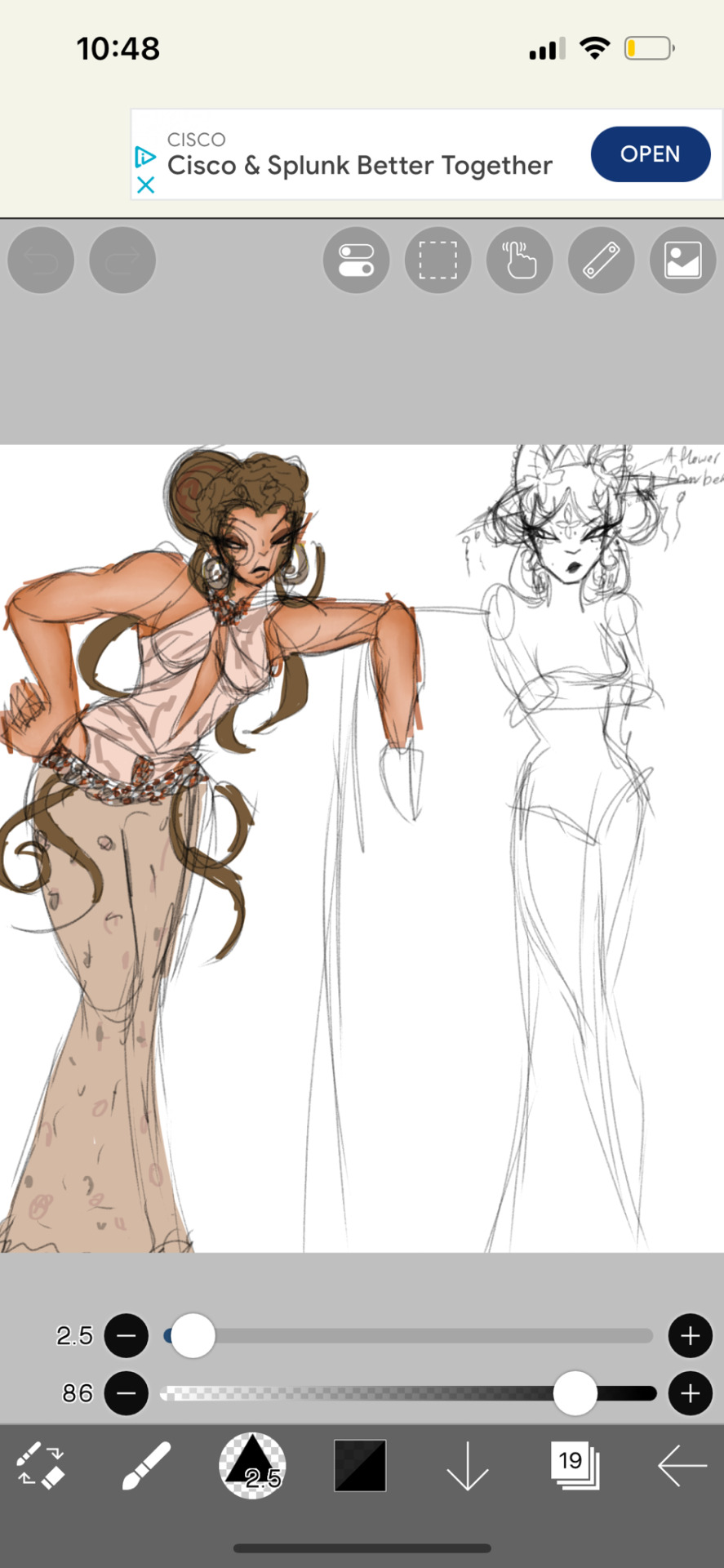

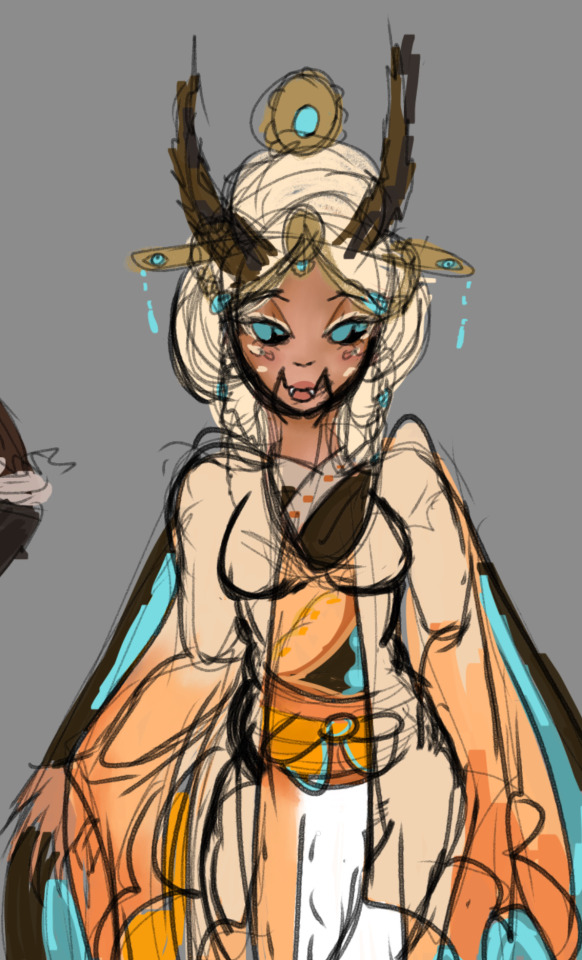
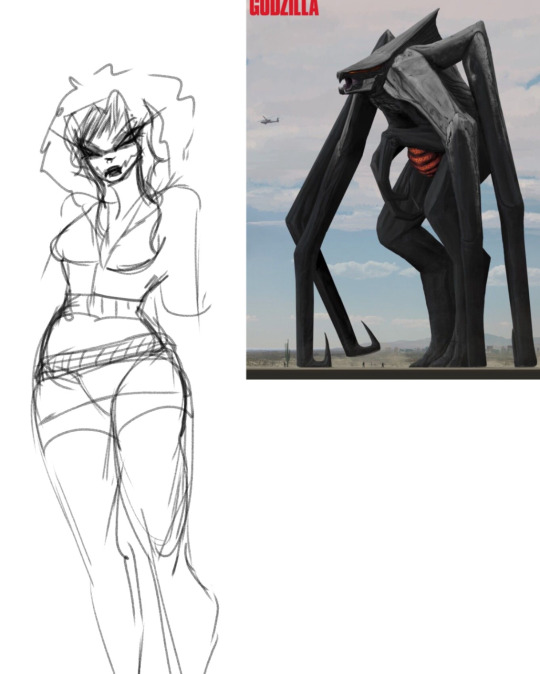
Shimo and Mothra are finished!!! Scylla might also be finished not sure yet but probably!! And the two I’m making right now are Barb and Tiamat!!
More abt up coming designs and now finished designs
Tiamat: I wanted to give Tia look based of Adriana Lima and a mixture of ancient Asian hairstyles and Ancient Greek attire!
Scylla: Scylla is mainly based of an outfit I had found on Pinterest that I thought would suit her and as for her hair I made it based of images of Ancient Greek hairstyles, I wanted to make sure her shell could be resembled more as a bun rather than a hat!
Barb: My favorite design(so far). I wanted to make her appearance more based of Mcbling/TrashyY2K due to her name being ‘Barb’. I just taught it would suit well and she looks quite nice so far!
Mothra: Mothra is mainly based of ancient Chinese attire! I wanted to do that due to a picture that came from Twitter, I taught it would be super nice and so I designed her off of 618-907 AD mid-Late Tang Dynasty and early(?) Tang Dynasty and also 220-589 AD Wei,Jin, Southern and northern Dynasties.

#artists on tumblr#digital art#drawing#human monster verse#kaijuverse#monster verse#human design#mothra#tiamat#scylla#female muto
14 notes
·
View notes
Text
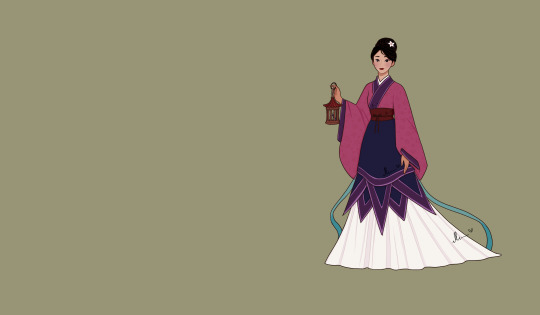
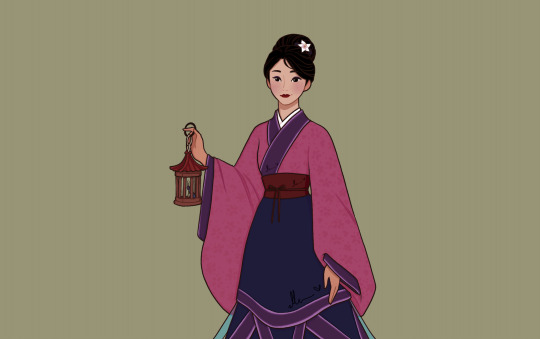
Mulan's second look in the movie is super iconic! So I did take some liberties so as to better the reference the movie. (Aka this look is obviously only semi-historical bc I wanted the movie references so..... here we go again!)
Still in the ~386–535 AD range of the Northern Wei or more generally the Northern & Southern Dynasties.
This look is based on fashion attributed to the Wei, Jin, Northern and Southern Dynasty time period: 220-589 AD.
I am the artist!!! Don’t repost without permission & credit! Thank you! Come visit me over on: Instagram , Patreon
#mulan#i did my best#can't do worse than the live action#mulan 1998#historically inspired disney princesses#historically inspired#historical fashion#lnart#digital illustration#ellenart#the great princess redesign#redesigning heroines#historical disney redesign
746 notes
·
View notes
Text
Tags by Country/Region/Ethnic Group
Afghanistan
Albania
Armenia
Bali
Benin
Bulgaria
Cameroon
Chad
China
Qin Dynasty (221-206 BC)
Han Dynasty (206 BC-220 AD)
Wei Dynasty (386-534)
Jin Dynasty (265-420)
Northern & Southern Dynasties (386-589)
Sui Dynasty (581-618)
Tang Dynasty (618-907)
Wu Zhou Dynasty (690-705)
Five Dynasties and Ten Kingdoms Era (907-979)
Song Dynasty (960-1279)
Yuan Dynasty (1271-1368)
Ming Dynasty (1368-1644)
Qing Dynasty (1636-1912)
Republic Era (1912-present)
Hanfu (modern)
Colombia
Croatia
Ecuador
Egypt
Eswatini
Ethiopia
Georgia
German (general region)
Ghana
Greece
Hungary
Indigenous
Apache
Blackfoot
Cherokee
Chimú
Chiricahua
Cree
Diné/Navajo
Guna
Haida
Haudenosaunee/Iroquois
Inca
Inuit
Kiowa
Lakota
Maori
Maya
Mixtec
Salish
Seneca
Sioux
Tehuana
Tlinglit
Tsimshian
Tsistsistas/Suhtai/Cheyenne
Rukai
India
Indonesia
Iran/Persia
Japan
Java
Kenya
Korea
Kyrgyzstan
Latvia
Lesotho
Libya
Macedonia
Mauritania
Mexico
Mongolia
Morocco
The Netherlands
Nepal
Nigeria
Norway
Panama
Palestine
The Philippines
Poland
Romania
Russia
Sardinia
Saudi Arabia
Scotland
South Africa
Zulu
Sudan
Swaziland
Taiwan
Tahiti
Tanzania
Thailand
Togo
Turkey
Ukraine
USA
Uganda
Uzbekistan
Vietnam
Yemen
Jewish
Central Asia
Pazyryk
Kazakh
North Asia
Yakut
Tuyan
Khakas
Mari
East Africa
Maasai
Kikuyu
Samburu
Turkana
West Africa
Igbo
Yoruba
North Africa
Imazigh
Kabyle
Central Africa
Bamileke
Polynesia
Balkans
Caucasus
Adygea
34 notes
·
View notes
Photo










The restoration of traditional Chinese clothing/Hanfu in theWei and Jin Dynasties, from裝束復原團隊(中國裝束復原小組)&coser小梦
Male Hanfu was in the Wei and Jin dynasties
The Wei and Jin Period (220 AD – 420 AD) refers to the period from The Three Kingdoms to the Two Jin Dynasties after the collapse of the Eastern Han Dynasty, commonly referred to as the preceding period of the Wei, Jin and Southern and Northern Dynasties (220 AD – 589 AD).
In Wei and Jin, “Wei” refers to the Northern regime of The Three Kingdoms, the Cao Wei and the Father and son regime of the Cao family, while “Jin” refers to the Jin Dynasty established by the Sima family
During the Wei and Jin dynasties, the state regime changed frequently, and the ideology was free and open. Great cultural development, literature, thought, art, calligraphy, music are born to influence the later generations of great people.
People’s comments on the characters changed from the moral style to the appearance of the characters, and then developed to the spiritual temperament of the characters, which was called Wei-Jin Romantic in the cultural history
#chinese hanfu#men's hanfu#china#china fashion#chinese fashion#fashion#historical costume#chinese costumes#chinese culture#hanfu#men's fashion
166 notes
·
View notes
Text
Rock color painting and mineral materials
During the Warring States, Qin and Han Dynasties (457 BC to 220 AD), great progress has been made in both silk paintings and murals in terms of color setting and skills. In 1949, in the Chu tomb on the sofa in Hunan Province, it was drawn with ink lines, painted with vermilion and earth red background, and painted with vermilion silk paintings on the lips and sleeves of the characters. Up to now, it has a history of more than 1300 years and is still as bright as before. The architectural sites of the ancient capital of Qin excavated in niuyang village, Yaodian Township, Xianyang City, Shaanxi Province, from the incomplete murals, the colors found are black, ochre (hematite) and stone green (malachite), with the largest proportion of black, followed by ochre and yellow. These colors have high saturation, and most of them are mineral pigments such as hematite, ilmenite and cinnabar.

The silk paintings of the Han Dynasty (2nd century BC) have reached a level of proficiency in composition, modeling and color. It can be said that it reflects the overall level of the use of mineral color at that time. Although the murals of Han tombs are not as meticulous as silk paintings, they are broad, magnificent and full of life. In the murals of the Han Dynasty, the pigments used include cinnabar, orpiment, stone green, chalk, animal colored clam powder (lamellibranchial fossils in Quaternary strata) and plant colored indigo naturalis.

During the Wei, Jin and Northern and Southern Dynasties (AD 220-589), the depth and breadth of mineral pigments were further improved.

The style of Buddhist culture and art is mainly represented by the murals of Ajanta Grottoes in Maharashtra state excavated in western India from the 7th century BC to the 2nd century BC. Ancient India is called "Gandhara art", which has a distinctive exotic atmosphere, and a large number of human bodies appear in the picture.

The painting style of Kucha passes through Khotan, Loulan and other countries in Western China on the ancient Silk Road to the ancient Kucha country in Xinjiang, forming the form of Kizil murals. Later, it passed through Dunhuang murals in Gansu, Maijishan murals in Tianshui to the Central Plains, and then through Korea to form Koguryo ancient tomb murals, which finally spread to Japan, forming a mural form represented by the Golden Hall mural of FaLong temple in the early stage of Nara. In the long process of Buddhism's eastward spread, Buddhist culture and Buddhist art forms have been integrated into each region's own culture and aesthetic consciousness to varying degrees, showing foreign cultures in different directions.
0 notes
Text
Discovering the world
China 🇨🇳
Basic facts
Official name: 中华人民共和国 (Zhōnghuá Rénmín Gònghéguó) (People’s Republic of China)
Capital city: Beijing
Population: 1.4 billion (2023)
Demonym: Chinese
Type of government: unitary socialist republic
Head of state: Xi Jinping (CCP General Secretary and President)
Head of government: Li Qiang (Premier)
Gross domestic product (purchasing power parity): $35.29 trillion (2024)
Gini coefficient of wealth inequality: 37.1% (medium) (2020)
Human Development Index: 0.788 (high) (2022)
Currency: renminbi (CNY)
Fun fact: It is home to half of the world’s pig population.
Etymology
The country’s name comes from the Sanskrit Cīna, which could refer to the Qin dynasty, the state of Jing, or Zina, the endonym for the inhabitants of Yelang.
Geography
China is located in East Asia and borders Mongolia and Russia to the north, North Korea to the northeast, the Pacific Ocean to the east, Vietnam, Laos, Myanmar, Bhutan, Nepal, and India to the south, Pakistan, Afghanistan, Tajikistan, Kyrgyzstan to the west, and Kazakhstan to the northwest.

There are ten main climates: monsoon-influenced extremely cold subarctic in the northernmost part, monsoon-influenced warm-summer humid continental and monsoon-influenced hot-summer humid continental in the northeast, humid subtropical and monsoon-influenced humid subtropical in the southeast, dry-winter tropical savanna and tropical monsoon in the south, tundra in the southwest, and cold steppe and cold desert in the west and northwest. Temperatures range from −10 °C (14 °F) in winter to 40 °C (104 °F) in summer. The average annual temperature is 10.7 °C (51.2 °F).

The country is divided into twenty-two provinces (shěng), five autonomous regions (zìzhìqū), four direct-administered municipalities (zhíxiáshì), and two special administrative regions (tèbié xíngzhèngqū). The largest cities in China are Shanghai, Beijing, Guangzhou, Shenzhen, and Tianjin.

History
10600-7500 BCE: Nanzhuangtou culture
7000-6500 BCE: Xiaohei culture
7000-6100 BCE: Pengtoushan culture
7000-5000 BCE: Peiligang culture
6500-5000 BCE: Cishan culture
6200-5400 BCE: Xinglongwa culture
6000-5000 BCE: Beixin culture; Dadiwan culture
5500-4800 BCE: Xinle culture
5500-3300 BCE: Hemudu culture
5400-4500 BCE: Zhaobaogou culture
5200-5000 BCE: Fuhe culture
5000-3300 BCE: Majiabang culture
5000-3000 BCE: Daxi culture; Yangshao culture
4700-2900 BCE: Hongshan culture
4300-2400 BCE: Dawenkou culture
3800-3300 BCE: Songze culture
3500-2000 BCE: Xiaoheyan culture
3400-2600 BCE: Qujialing culture
3300-2300 BCE: Liangzhu culture
3000-1900 BCE: Longshan culture
2500-2000 BCE: Shijiahe culture
2200-1600 BCE: Lower Xiajiadian culture
2070-1600 BCE: Xia dynasty
2000-1600 BCE: Erlitou culture
1600-1400 BCE: Erligang culture
1600-1046 BCE: Shang dynasty
1046-256 BCE: Zhou dynasty
1000-600 BCE: Upper Xiajiadian culture
221-206 BCE: Qin dynasty
202 BCE-9 CE, 25-220: Han dynasty
9-23: Xin dynasty
220-266: Cao Wei
221-263: Shu Han
222-280: Eastern Wu
266-420: Jin dynasty
304-439: Sixteen Kingdoms
386-535: Northern Wei
420-479: Liu Song
479-502: Southern Qi
502-557: Liang
534-550: Eastern Wei
535-557: Western Wei
550-577: Northern Qi
555-587: Western Liang
557-581: Northern Zhou
557-589: Chen
581-618: Sui dynasty
618-690, 705-907: Tang dynasty
690-705: Wu Zhou
907-979: Five Dynasties and Ten Kingdoms
916-1125: Liao dynasty
960-1279: Song dynasty
1271-1368: Yuan dynasty
1368-1644: Ming dynasty
1644-1912: Qing dynasty
1839-1842: First Opium War
1850-1864: Taiping Rebellion
1851-1868: Nian Rebellion
1855-1868: Punti-Hakka Clan Wars
1856-1860: Second Opium War
1856-1873: Panthay Rebellion
1862-1877: Dungan Revolt
1894-1895: First Sino-Japanese War
1899-1901: Boxer Rebellion
1911: Wuchang Uprising; Xinhai Revolution
1912-1949: Republic of China
1919: May Fourth Movement
1927-1936, 1945-1949: Chinese Civil War
1931-1937: Chinese Soviet Republic
1937-1945: Second Sino-Japanese War
1949-present: People’s Republic of China
1950: annexation of Tibet
1989: Tiananmen Square protests
1997: return of Hong Kong
1999: return of Macau
Economy
China mainly imports from the European Union, Taiwan, and South Korea and exports to the United States, the European Union, and Japan. Its top exports are data-processing machines, radio transmission tools, and electronic integrated circuits.
It has transitioned from an economy focused on manufacturing consumer products to one centered on high-tech industries. Services represent 54.6% of the GDP, followed by industry (38.3%) and agriculture (7.1%).

China is a member of Asia-Pacific Economic Cooperation, the BRICS, the G20, and the Shanghai Cooperation Organization.
Demographics
The Han constitute 91.5% of the population, followed by the Zhuang (1.2%), Manchu (0.8%), Uyghur (0.7%), Hui (0.7%), and Miao (0.7%). The main religion is Buddhism, practiced by 33.4% of the population.

It has a negative net migration rate and a fertility rate of 1 child per woman. 64.6% of the population lives in urban areas. Life expectancy is 76.3 years and the median age is 38.4 years. The literacy rate is 99.8%.
Languages
The official language of the country is Mandarin, spoken by 64% of the population as their first language. Other languages are official in their respective provinces or prefectures: Cantonese, English, Kazakh, Korean, Mongolian, Portuguese, Tibetan, Uyghur, Yi, and Zhuang.

Culture
Chinese culture has been heavily influenced by Confucianism. Elders are highly esteemed, and there is a great pressure to have children.
Men traditionally wear an open cross-collar shirt (yī), a long, wrap-around skirt (cháng) or pants (kù), and cloth shoes (lü). Women wear an open cross-collar shirt (rù) and a long, wrap-around skirt (qún) or a tight-fitting dress with two side slits (qípáo) and cloth shoes (lü).

Architecture
Traditional houses in China are symmetric and made of wood and stone, have an open courtyard and upturned eaves.

Cuisine
The Chinese diet is based on meat, noodles, rice, and vegetables. Typical dishes include chow mein (a dish of stir-fried noodles with vegetables and meat or tofu), mapo tofu (tofu in a hot and spicy sauce), Peking duck (roasted duck served with cucumber, spring onions, and sweet bean sauce), tangyuan (glutinous rice balls filled with black sesame paste and served in a hot broth or syrup), and wonton soup (a chicken broth with dumplings stuffed with meat and prawns).

Holidays and festivals
China celebrates New Year’s Day, Spring Festival in late January or early February, Tomb-Sweeping Day on April 5, Labor Day, Dragon Boat Festival on the fifth day of the fifth month of the traditional Chinese calendar, Mid-Autumn Festival on the 15th day of the eighth month, and National Day on October 1.

Mid-Autumn Festival
Other celebrations include the Double Ninth Festival, when it is customary to climb a mountain, drink chrysanthemum liquor, and wear the zhuyu plant; the Hungry Ghost Festival, when the family’s ancestral tablets are placed on a table and incense is burned to avoid the wrath of the ghosts, and the Snow and Ice Festival, which features ice sculptures.

Snow and Ice Festival
Landmarks
There are 57 UNESCO World Heritage Sites: Ancient Building Complex in the Wudang Mountains, Ancient City of Pingyao, Ancient Villages in Southern Anhui – Xidi and Hongcun, Archeological Ruins of Liangzhu City, Capital Cities and Tombs of the Ancient Koguryo Kingdom, Chengde Mountain Resort and its Outlying Temples in Chengde, Chengjiang Fossil Site, China Danxia, Classical Gardens of Suzhou, Cultural Landscape of Honghe Hani Rice Terraces, Cultural Landscape of Old Tea Forests of the Jingmai Mountain in Pu’er, Dazu Rock Carvings, Fujian Tulou, Grand Canal, Great Wall, Historic Center of Macau, Historic Ensemble of the Potala Palace, Historic Monuments of Dengfeng in “The Center of Heaven and Earth”, Huanglong Scenic and Historic Interest Area, Hubei Shennongjia, Imperial Palaces of the Ming and Qing Dynasties, Imperial Tombs of the Ming and Qing Dynasties, Jiuzhaigou Valley Scenic and Historic Interest Area, Kaiping Diaolou and Villages, Kulangsu: a Historic International Settlement, Longmen Grottoes, Mausoleum of the First Qin Emperor, Migratory Bird Sanctuaries along the Coast of Yellow Sea-Bohai Gulf, Mogao Caves, Mount Emei Scenic Area, Mount Fanjing, Mount Huangshan, Mount Qingcheng and the Dujiang Irrigation System, Mount Sanqing, Mount Tai, Mount Wutai, Mount Wuyi, Mountain Lu National Park, Old Town of Lijiang, Peking Man Site at Zoukoudian, Qinghai Hoh Xil, Quanzhou: Emporium of the World in Song-Yuan China Sichuan Giant Panda Sanctuaries, Silk Roads: the Routes Network of Chang’an-Tianshan Corridor, Site of Xanadu, South China Karts, Summer Palace, Temple and Cemetery of Confucius and the Kong Family Mansion in Qufu, Temple of Heaven, Three Parallel Rivers of Yunnan Protected Areas, Tusi Sites, West Lake Cultural Landscape of Hangzhou, Wulingyuan Scenic and Historic Interest Area, Xinjiang Tianshan, Yinxu, Yungang Grottoes, and Zuojiang Huashan Rock Art Cultural Landscape.

Zhangjiajie National Forest Park
Other landmarks include the Huangguoshu Waterfall, the Oriental Pearl TV Tower, the Reed Flute Cave, the Saint Sophia Cathedral, and the Three Gorges Dam.

Saint Sophia Cathedral
Famous people
Gong Li - actress
Jackie Chan - actor
Lang Lang - pianist
Li Po - poet
Liu Yifei - actress and singer
Mo Yan - writer
Peng Shuai - tennis player
Yan Geling - writer
Yang Liping - dancer
Yao Ming - basketball player

Lang Lang
You can find out more about life in China in this article and this video.
#discoveringtheworld#langblr#cantonese#english#kazakh#korean#mandarin#mongolian#portuguese#tibetan#uyghur#yi#zhuang
4 notes
·
View notes
Photo

Who is ready to explore a world filled with ancient dynasties. "The Six Dynasties is a collective term for six Chinese dynasties during the periods of the Three Kingdoms (220–280 CE; also known as the Eastern Wu or the Cao Wei), the Jin Dynasty (265–420 CE), and the Southern and Northern Dynasties (420–589 CE), which included the Liu Song, Southern Qi, Liang, and Chen Dynasties." There is so much to learn and do in China contact us today about our cultural ambassador program. Send us an email today for more details [email protected] Call us 1-902-422-1455 https://www.instagram.com/p/B3MvipSHcwq/?igshid=1tgqz2cbby5x6
0 notes
Note
What are the best resources for learning about ancient and medieval Chinese history? Are there any books you recommend?
I love this question! I am a bit more in touch with “Medieval” Chinese history, although the height of medieval in China wouldn’t necessarily align with the height of the “medieval” in Europe.
I’ll put my answer below the cut.
Like this answer? Want to Support Asian History? Leave us a tip! Keep History Diverse.
These terms are always a bit flexible anyways – but my personal rule of thumb is that the Tang Dynasty could be used to mark a true shift from ancient/late antiquity to medieval.
However, we can also think of the dynasties as Ancient, Ancient-Early Imperial (or Late Antiquity), Mid-Imperial/Medieval, and Late Imperial.
Neolithic - Ancient [8500 BCE - 221 BCE] is therefore roughly the Neolithic and semi-“mythic” Xia dynasty, plus the Shang and Zhou dynasties, and what we refer to as the Spring and Autumn period, and the Warring States period. This period “ends” with the formation of the Qin dynasty.
Early Imperial China (Ancient-Late Antiquity or Early Medieval) - [221 BCE - roughly 5th-7th century CE.] This is where the divisions of the imperial periods become somewhat imperfect. I’ll explain how:
Late Antiquity makes sense further west and in Europe: with the division of the Roman empire and the rise of the Byzantine empire, the invasions of the ��barbarians” in Rome, the shift of the Roman Empire to having Christianity as a state religion, later Roman-Persian (Sassanid) wars and the eventual fall of the Sassanid empire to none other than the earliest Arab-Muslim Armies. So you have major radical shifts in religion and culture which occur with the rise of Christianity and Islam in the west, which is the tail end of a period of “antiquity” you could argue for.
But this doesn’t quite impact China in the same way as it does the rest of the world. We know for a fact that Buddhism has reached the Han Dynasty, but unlike the introduction of Christianity or Islam, it doesn’t seem to bring with it a radical upheaval of the entire religious and social structure of China or the dynasty. Comparatively, the rise of Christianity from the 1st to the 3rd centuries represents a tidal shift where the Roman Empire ends up enforcing Christianity as the new state religion as opposed to the previous Roman (pagan) state religion. The 7th century bears witness to the rise of Islam and the death of the Persian Sassanid Empire. Obviously this is the most broad and generalist possible way of describing this period, and the changes did occur over a few centuries as opposed to “all at once.”
But by comparison, I wouldn’t say Buddhism overthrows Confucianism, Daoism, or Chinese folk religion at all. It doesn’t even upend the Han Dynasty. However the fall of the Han Dynasty does mark a tumultuous period of successive kingdoms and dynasties.
Instead of trying to act like there’s a definitive way to define these periods, I’ll just briefly name the dynasties that are spread across a transition between ancient and medieval.
Qin Dynasty 221 BCE - 206 BCE
Han Dynasty 206 BCE - 220 CE (incl. Western Han and Eastern Han, interrupted by the Xin Dynasty) [Here marks a transition to many shorter kingdoms and dynasties]
Three Kingdoms - Wei, Wu, and Shu 220 CE - 280 CE
Jin Dynasty (Eastern and Western) 265–420 CE - overlapping with the Sixteen Kingdoms.
Northern and Southern Dynasties 420–589 CE
Sui Dynasty 581–618 CE
And we arrive at the Tang Dynasty, which is decisively “Medieval China.”
Medieval China / Mid-Imperial 618 CE - 14th Century
Tang Dynasty
Second Zhou Dynasty
Five Dynasties and Ten Kingdoms Period
Liao Dynasty (also called the Khitan-Liao)
Song Dynasty (Northern Song, Southern Song)
Xia Dynasty
Jin Dynasty
Yuan Dynasty/Mongolian Empire
But this doesn’t include all kingdoms which were located in what is today Modern China (like the state of Yan, or the Da Chang He kingdom, etc.) A lot of these also overlap.
So what’s left is resources! You’ll have a lot more to work with if you can read or translate Chinese or tackle Classical Chinese (no easy feat!), but I’ll focus on English language resources.
Early Medieval China, the journal, some of which is hopefully open access (it’s marked that authors can choose to make their articles OA.) This covers the end of the Han Dynasty [220 CE/3rd century CE] to the beginning of the Tang dynasty [618 CE/7th century CE].
International Dunhuang Project - (Silk Routes & the Dunhuang caves)
Yale Silk Road Database
Visual Sourcebook of Chinese Civilization (a bit…dated website wise, but still.)
Chinese Archaeology
Need primary sources? Chinese Text Project (Cn + En)
Asian Art Museum - Chinese Archaeology & Education resources
Asia For Educators (Columbia) - Bronze Age China
The problem with books is that many are either dense and over specific academic texts on literature, art, religion, etc or they are overly broad and cram in as much Chinese history as they can (see: Keay or Fairbank’s “History of China” books.) Books targeted towards non-academic audiences tend to go just by dynasty or by subject, and given how small the results I got on Amazon books for “Ancient Chinese History” was, I have no doubt you’ve already found those books. I would strongly recommend using Asia for Educators, the Asian Art Museum, and the above Silk Road related websites for generalized interests.
In lieu of presenting you with overly specialized stuff, I’d check the Met Museum’s Chinese related books (some of which will be free for download.) Who doesn’t love pictures and context? I come back to these again and again personally.
If you happen to be able to make it there, The Metropolitan Museum of Art currently has a large exhibition that should interest called Age of Empires: Chinese Art of the Qin & Han Dynasties, which is ongoing through July 16th.
Hope this helps!
183 notes
·
View notes